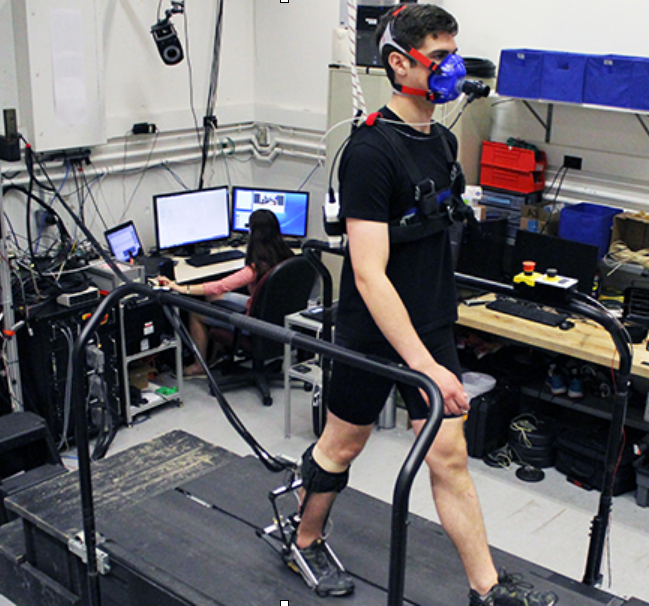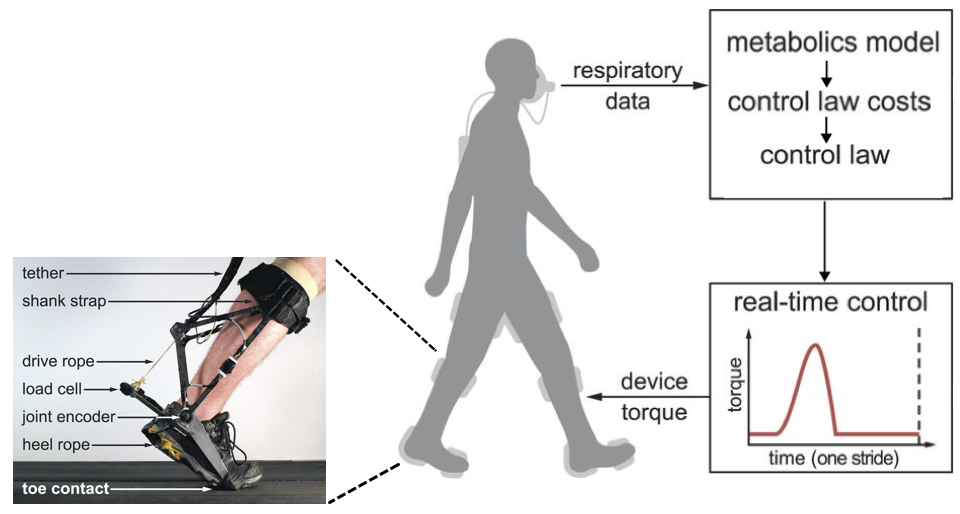Smart algorithm automatically adjusts exoskeletons for best walking performance
June 25, 2017

Walk this way: Metabolic feedback and optimization algorithm automatically tweaks exoskeleton for optimal performance. (credit: Kirby Witte, Katie Poggensee, Pieter Fiers, Patrick Franks & Steve Collins)
Researchers at the College of Engineering at Carnegie Mellon University (CMU) have developed a new automated feedback system for personalizing exoskeletons to achieve optimal performance.
Exoskeletons can be used to augment human abilities. For example, they can provide more endurance while walking, help lift a heavy load, improve athletic performance, and help a stroke patient walk again.
But current one-size-fits-all exoskeleton devices, despite their potential, “have not improved walking performance as much as we think they should,” said Steven Collins, a professor of Mechanical Engineering and senior author of a paper published published Friday June 23, 2017 in Science.
The problem: An exoskeleton needs to be adjusted (and re-adjusted) to work effectively for each user — currently, a time-consuming, iffy manual process.
So the CMU engineers developed a more effective “human-in-the-loop optimization” technique that measures the amount of energy the walker expends by monitoring their breathing* — automatically adjusting the exoskeleton’s ankle dynamics to minimize required human energy expenditure.**

Using real-time metabolic cost estimation for each individual, the CMU software algorithm, combined with versatile emulator hardware, optimized the exoskeleton torque pattern for one ankle while walking, running, and carrying a load on a treadmill. The algorithm automatically made optimized adjustments for each pattern, based on measurements of a person’s energy use for 32 different walking patterns over the course of an hour. (credit: Juanjuan Zhang et al./Science, adapted by KurzweilAI)
In a lab study with 11 healthy volunteers, the new technique resulted in an average reduction in effort of 24% compared to participants walking with the exoskeleton powered off. The technique yielded higher user benefits than in any exoskeleton study to date, including devices acting at all joints on both legs, according to the researchers.
* “In daily life, a proxy measure such as heart rate or muscle activity could be used for optimization, providing noisier but more abundant performance data.” — Juanjuan Zhang et al./Science
** Ankle torque in the lab study was determined by four parameters: peak torque, timing of peak torque, and rise and fall times. This method was chosen to allow comparisons to a prior study that used the same hardware.
Science/AAAS | Personalized Exoskeletons Are Taking Support One Step Farther
Abstract of Human-in-the-loop optimization of exoskeleton assistance during walking
Exoskeletons and active prostheses promise to enhance human mobility, but few have succeeded. Optimizing device characteristics on the basis of measured human performance could lead to improved designs. We have developed a method for identifying the exoskeleton assistance that minimizes human energy cost during walking. Optimized torque patterns from an exoskeleton worn on one ankle reduced metabolic energy consumption by 24.2 ± 7.4% compared to no torque. The approach was effective with exoskeletons worn on one or both ankles, during a variety of walking conditions, during running, and when optimizing muscle activity. Finding a good generic assistance pattern, customizing it to individual needs, and helping users learn to take advantage of the device all contributed to improved economy. Optimization methods with these features can substantially improve performance.